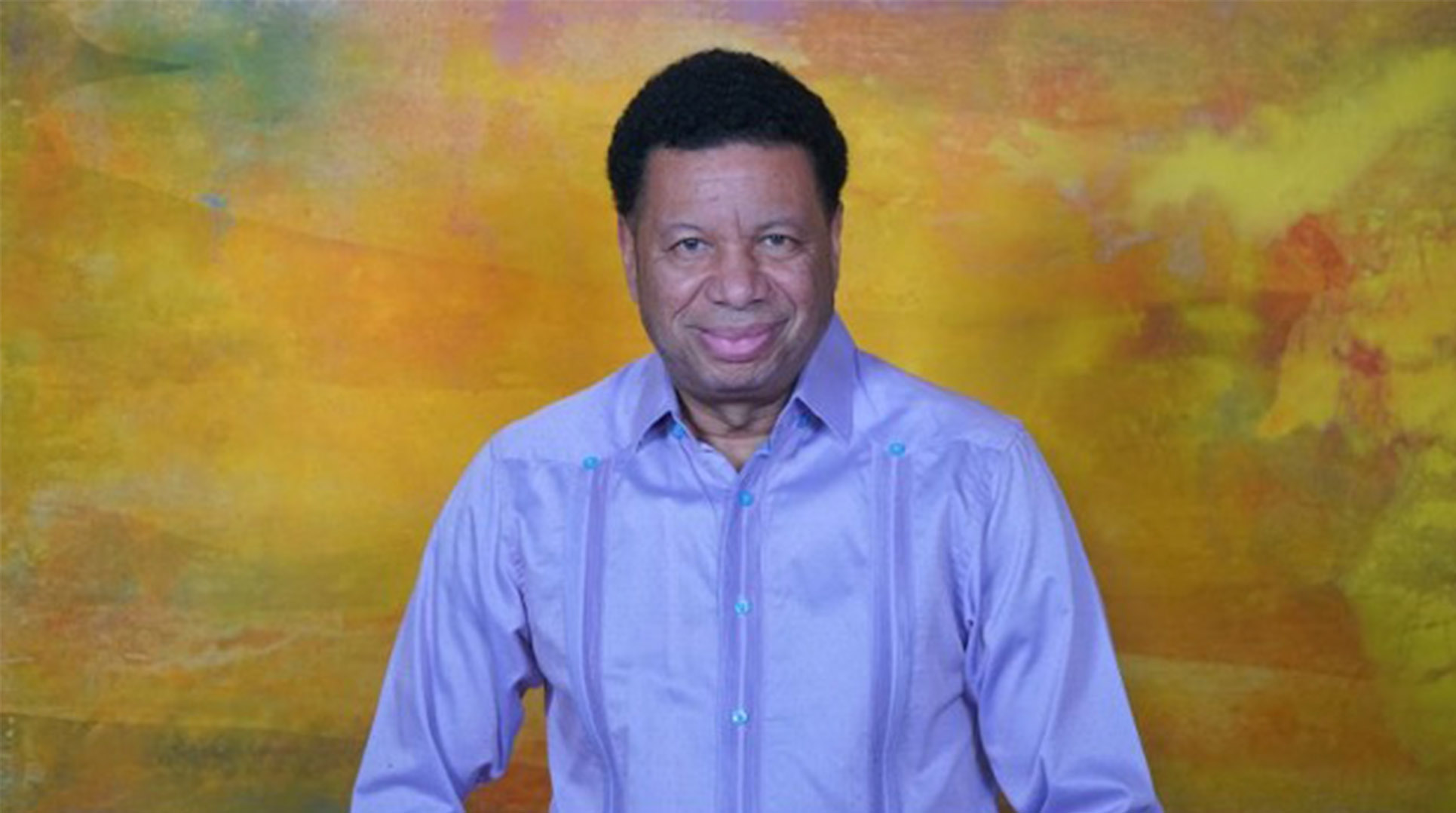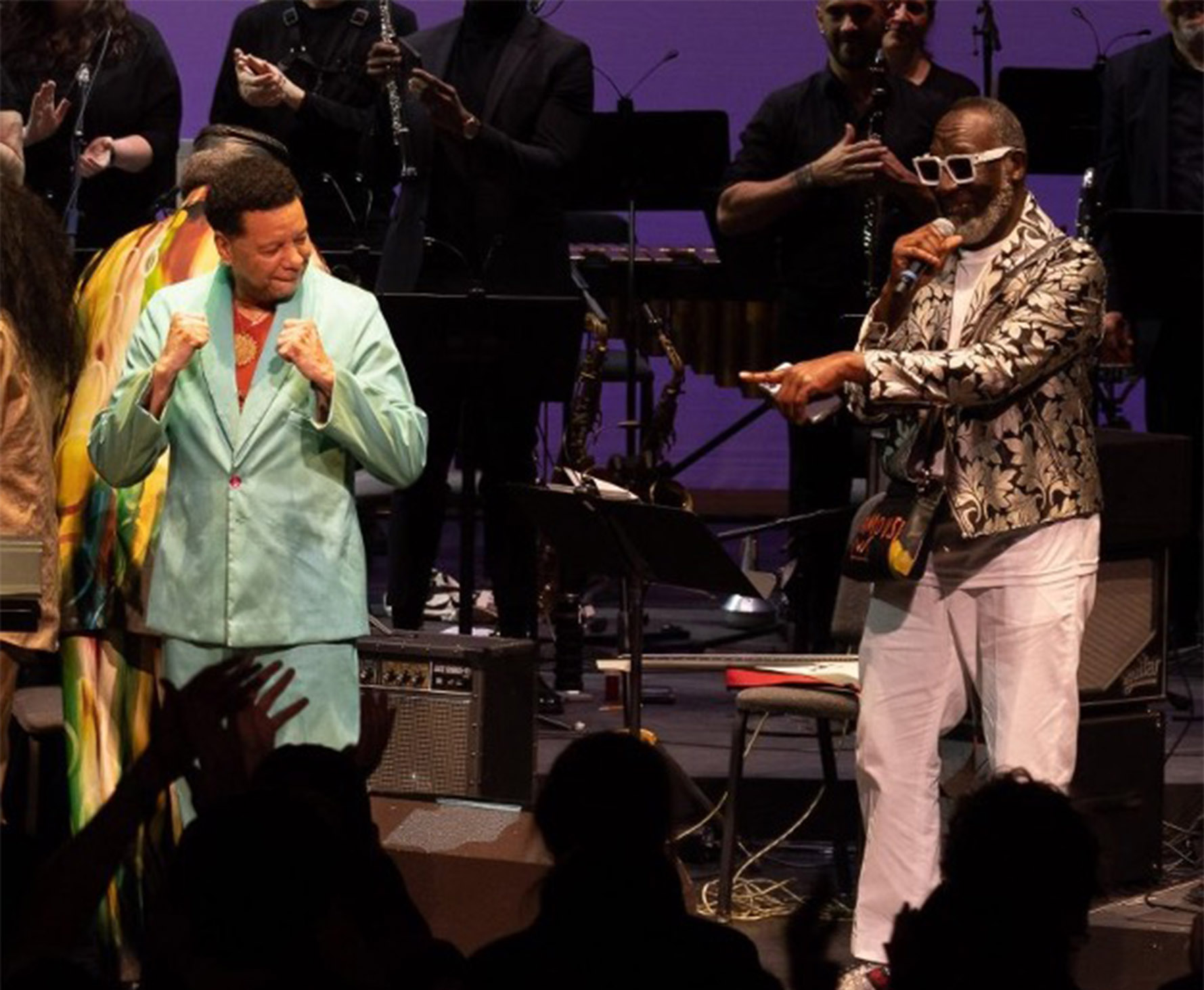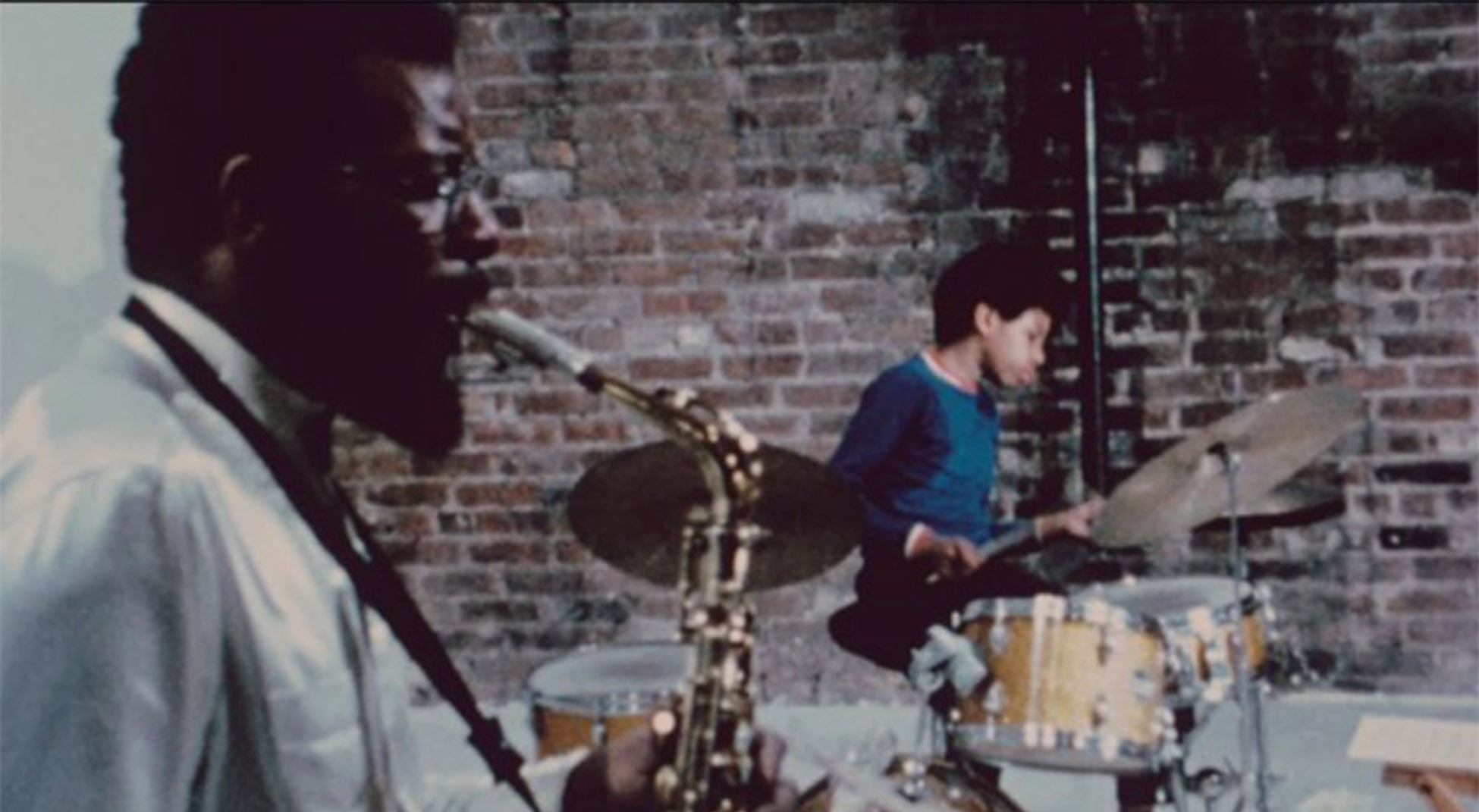Los Angeles 1956, born into the family business. Art & Awareness. Mother poet, Jayne Cortez. Father 1 musician composer, Ornette Coleman. Father 2 sculptor, Melvin Edwards. Started playing the drums at 6. By 10 was in Rudy Van Gelder’s studio recording a trio record with my father and Charlie Haden (The Empty Foxhole, Blue Note). By 12 had been to 20 countries In Europe, Asia & Africa playing at Universities and Festivals. My father made a point in 1962 to stop playing in basement Jazz clubs. Instead he only played concert stages or starved.
1970’s school in the winter, music in the summer. 1980 started the Firespitter band with my mother. Poetry & Music. She is the only poet to have her own band for 30 years. Shortly thereafter in my mid 20’s I began managing my father’s career. The music business was out of synch with him & he was out of synch with it. We became more independent. I began producing records and booking tours.
Next I started producing Ornette Festivals. Events that would be hosted by other Festivals. We would channel Harmolodic ideas through many different artists and configurations.
1990’s opened Harmolodic Recording studio in Harlem on 125th st. The only studio uptown with a Neve 72” channel console. Launched the Harmolodic Record label in partnership with Verve / Universal.
By the 2000’s the top to bottom realignment of the record industry prompted us to focus on the Harmolodic festivals and tour ventures.
During 2010’s both parents passed on having made an incredible impact. But the Soul and the Art of a person never dies.
I am a Harmolodic person……accepting energy from multiple dimensions. Not limited by man made institutions or attitudes. Art is ideas. Besides the body ideas are the platform of life. The more abstract the more life gets extended. People usually resist. That’s why there are Artists.
Current Projects
Producer ORNETTE-FESTIVALS
1990 In All Languages, Reggio Emilia Italy
1997 Civilization, Lincoln Center, Paris, Italy
2000 Global Expressions, Battery Park NY
2009 Meltdown, London
2014 Celebrate Ornette, Brooklyn
2017 Tomorrow Is The Question, Lincoln Center
Artists: Al Macdowell, Antoine Roney, Antony Hegarty, Baaba Maal, Badal Roy, Bang On A Can, Bern Nix, Bill Frisell, Bill Laswell, Billy Higgins, Bobby Mcferrin, Branford Marsalis, Bruce Hornsby, Calvin Weston, Carla Bley, Cecil Taylor, Charlie Ellerbe, Charlie Haden, Charnett Moffett, Chris Walker, Dave Bryant, David Murray, Don Cherry, Evan Parker, Flea, Geri Allen, Han Bennink , Henry Theadgill, Howard Shore, Jamaaladeen Tacuma, James Blood Ulmer, Jaques Derrida, Jason Moran, Joachim Kuhn, Joe Lovano, John Zorn, Joshua Redman, Kenny Baron, Kenny Wessel, Kidd Jordan, Laurie Anderson, Lee Konitz, Lou Reed, Marc Ribot, Mark Ronson, Master Musicians of Jajouka, Mike Patton, Moby, Nels Cline, New York Phiharmonic, Pat Metheny, Patti Smith, Pharoah Sanders, Robert Wyatt, Savion Glover, Sean Lennon, Signal Ensemble, Steve Reid, Sultan Khan, Tenores Di Bitti, The Bad Plus, The Roots, Thurston Moore, Tony Falanga, Vernon Reid, VV Brown, Wallace Roney, Yo La Tengo, Yoko Ono
Paris Shape Of Jazz To Come 2025
Who’s Ornette? Who’s Denardo?
The Shape of Jazz To Come Orchestra Concert promo 2024
Peace, feat Moor Mother Orchestra Arr by Craig Harris
Eventually, Orchestra Arr by Nicole Mitchell
Naked Lunch Live
Ornette’s Intro To Harmolodics
Cuba Is Now
Ornette’s Meltdown Festival
Shape Of Jazz To Come Orchestra Concert
Ornette on SNL? How?
Jayne Cortez Rape
Ornette & Prime Time Italy 1980
Prime Time, San Francisco 2017
Broadway Blues, Henry Threadgill, Flea
Jayne Cortez I Am New York City
Realizations One
Celebrate Ornette All-Star Tribute
Jayne Cortez I See Chano Pozo
Ornette footage, thank you director Shirley Clarke for the film Ornette: Made In America
Site Photo Credits: Nathaniel Phillips, Elliot Landy, Alan Nahigian, Stephanie Berger
DENARDO BLUES CONNOTATION
Special Guests: Henry Threadgill, Flea
Antoine Roney, Al Macdowell, Tony Falanga, Charlie Ellerbe
Denardo Coleman: Like Father, Like Son
He’s still in his prime time—and keeping the heart of Ornette’s harmolodics beating
PUBLISHED NOVEMBER 21, 2022 – BY A.D. AMOROSI

Denardo Coleman (photo courtesy of the artist)
Before we enter the current world of drummer, producer, and curator Denardo Coleman, a funny story from the past.
In 1996, the year after the Coleman family had established the Harmolodic record label through Verve/PolyGram, Denardo’s father, saxophonist/composer Ornette Coleman, dropped two new albums, Sound Museum: Three Women and Sound Museum: Hidden Man, while his mother, spoken-word artist Jayne Cortez, released Taking the Blues Back Home. At the same time, Harmolodic put out several of the saxophonist’s earlier works once solely offered through the indie Artists House, including 1978’s Body Meta with Ornette’s electric band Prime Time and Soapsuds, Soapsuds, recorded in 1977 with bassist and longtime friend Charlie Haden. Denardo helped work through the new label’s minutiae, as well as dealing with all of its press.
Assigned to interview Denardo about the rhythmic role he’d played in many of his father’s ensembles since childhood, as well as discussing his new entrepreneurial efforts, this writer phoned Harmolodic’s Harlem office, only to get a man on the line who was obviously disguising his voice, insisting that “no one’s home” and that he was “the janitor.”
After a minute, sensing I was being pranked, I asked the obvious question: “Is this Ornette Coleman?”
The saxophonist laughed and said, “Hang on. I’ll go get my son. He’s expecting you.”
Given Ornette’s history—the way he set the avant garde on its heels with 1959’s The Shape of Jazz to Come, his pioneering work in the land of the free, his creation of the harmolodic theory of music (which, among other things, de-emphasizes the concept of keys or tonal centers)—it can be easy to conclude that he was never anything but serious. But that’s not true at all. Reminded of this story now, the 66-year-old Denardo says, “My father was a funny man.”
This year, that easy humor, along with Ornette’s many other compelling traits, has been celebrated with vinyl box sets of both his first recordings for Lester Koenig’s Contemporary label in the late ’50s (Genesis of Genius: The Contemporary Albums) and his Blue Note years from 1966 to 1968 (Round Trip). Other vintage Ornette sessions are in the process of being compiled by Denardo with help from archivist/producer Michael Cuscuna. And soon there will be another, newly recorded multi-package to join them in tribute to the jazz revolutionary who passed in 2015 at the age of 85: Ornette Coleman: The Shape of Jazz to Come.
Produced and curated by Denardo (who also played drums) and cut live in May 2022 at the Brooklyn Academy of Music (BAM), this re-envisioning of his dad’s ’59 classic involved the Bang on a Can Orchestra, Ornette collaborators such as guitarist James “Blood” Ulmer and bassist Jamaaladeen Tacuma, fans like pianist Jason Moran, a handful of young composers (Nick Dunston, Craig Harris, Nicole Mitchell, Carman Moore, David Sanford, Pamela Z), and conductor Awadagin Pratt. “There were a lot of different energies in that room,” Denardo says of the BAM jam and its rehearsals, all captured by multiple cameras for documentary purposes.
The concert began as a joint commission of BAM and the Bang on a Can group. “We couldn’t do that which was originally planned, the Skies of America celebration, as that was just too big,” Denardo says, referring to his father’s 1972 orchestral work, originally performed and recorded by the London Symphony. “I came up with the idea of revisiting his 1959 album’s six songs and approaching six different composers to make new arrangements—really new compositions by the time each was finished—inspired by Ornette, with the orchestra and hand-picked musicians I called Ornette Expressions all playing together. And it was unbelievable.”
Noting that the name “Ornette Expressions” allows for the inclusion of all of the saxophonist’s many projects, Denardo says that he intends to keep the repertory group going, with interchangeable players and settings: “I’m getting out and going around the world finding younger musicians who are harmolodically oriented, such as [trumpeter] Wallace Roney Jr. and [multi-reedist] Lee Odom.” Both took part in the BAM show.
“Lee had the toughest job that night, playing the sax,” Denardo acknowledges. “But she and I have been playing together a while now, learning and studying together. Wallace and I played together too. That band—Lee, Wallace, Jamaaladeen—we rehearsed and rehearsed and rehearsed like Ornette did, over and over with his people, because it’s never just about learning the melodies or rhythms. You have to get inside the properties of the sound so that you can really tell stories in the moment. That takes a lot of exploration.”

Denardo Coleman gets the point from Jamaaladeen Tacuma (right) at the Brooklyn Academy of Music’s May 2022 Shape of Jazz to Come concert (photo courtesy of Denardo Coleman)
As Denardo explores his own history, it causes him to say something surprising. “I can’t say that I’m interested in drumming, so to speak. Or ever was. But I was interested in what the drummers who played with my father—Billy Higgins, Ed Blackwell, Charles Moffett—were doing. The three of them are in my head, even now they’re ringing through me as I’m playing. This is true.”
In the first of many basketball analogies we share, Denardo refers to Higgins in particular as occupying the point-guard position in Ornette’s quartet. “When you have a really good point guard, he can control the whole flow of the game. He doesn’t have to score a lot, but he’s five steps ahead of whatever’s happening on the floor. It’s invisible, though, totally not tangible. The point guard is setting other people up to get to their sweet spot. That’s Billy. He didn’t have to slam dunk. He created an environment where things could flow in particular ways. Getting your teammates into a certain rhythm.”
Denardo asked for his own drum kit when he was six. Not long after, he was jamming with his dad in the garage of their Los Angeles home. At 10, he was playing with Ornette in the recording studio (on the same 1966 album, The Empty Foxhole, where the elder Coleman fixed his untrained eye on violin and trumpet). And, perhaps not coincidentally, he actually played point guard on his high school’s basketball team. “We were good, New York private-school good,” he laughs. “I had the whole field in my vision, but I always had to remember that my dad’s music requires a different kind of a point guard. I couldn’t compare myself to others. I mean, Steph Curry is the best three-point shooter in the NBA of all time, but in the era where no one was shooting threes, no one was developing that [skill]. It was a different game in the past than it is in the present and will be in the future.”
As that “different kind of a point guard” behind the drums, the young Coleman had no idea how people learned or taught music. “People other than my father, that is,” he says. “Now I understand that better too. But Ornette [felt] that anybody is capable of expressing anything, and at any age. He was teaching me music, but not teaching me the drums. I mean, I had some outside drum lessons, but he wasn’t interested in that.”
The lessons Denardo did learn from his father were never hierarchical and completely bypassed the usual student/teacher dynamic. “Ornette treated me like an adult, always, asking my opinions … I didn’t realize that that wasn’t the norm. He was just wired a different way. I look back at a record like Empty Foxhole, and it’s not so much about the playing as it is the conversation, the exploration, the two- and three-hour talks that he would have before the rehearsals, enlightening us as to taking it all further. Empty Foxhole is me processing his conversation at 10 years old. Sound Museum is me processing his conversation at age 40. That’s fine for me.”
So what kind of rhythmic language did Denardo bring to that conversation? “I don’t think I have one, then or now,” he says with a laugh. “Never even thought about it. From the first album we did, I never had to think about being ‘locked in.’ In a harmolodic zone, you’re just so wide open that things change moment to moment. You’re reacting. No being tied down to go-tos. It is the opposite of one signature. You don’t want to be pinned down or have a pinned-down attitude. You’re just going with it. Ninety-nine percent of musicians get acquainted with the role first. The rules. With us, it was expression. It was playing.”
It’s for this very reason that Coleman hasn’t played with many people outside his father’s musical circle. The albums he’s made as a more traditional sideman can safely be counted on the fingers of one hand (they include dates with Ulmer and with Moffett’s son, the late bassist extraordinaire Charnett Moffett). “Because I have no interest in the role,” he laughs. “When you’ve been fortunate to have played in the environment that I have for so long—an environment that is truly engaging, an environment that was always right there—that’s what you want. What you crave. There was always so much to respond to with him. But he’s one of one.
“Now nobody’s Ornette, so I know that I’m going to have to generate more of the conversation. But interesting players are usually up for interesting conversation. For me to play, I have to be interested. Having played with Ornette so much, I know how to make things interesting, or at least I think I do. Best to look for those environments.”

Ornette and Denardo Coleman in action, 1968 (photo courtesy of Denardo Coleman)
Several years ago, Denardo Coleman attended the opening of a friend’s exhibition at an art gallery in Havana, Cuba. Once there, he felt a desire to play with local musicians, and so a series of sessions was organized at Areito Studios (run by EGREM, Cuba’s national record label) and its basement boîte Club EGREM. Fifteen players were there, mostly percussionists and horn people. “These guys were killing in the club at night, and I invited them upstairs during the day to play,” Denardo says. “I wanted to see if I could start a harmolodic band, from scratch, with these musicians in Cuba.”
For nearly a year, Coleman traveled back and forth to Havana, hanging, rehearsing, and talking with these young musicians, just as his father had done with him. The biggest attraction was that he was going someplace where they had no idea who his father was, somewhere far apart from the “free jazz” conversation. “I wanted to be where there was no baggage,” he says. “And once they got to harmolodics, everything opened up. But they have to get to harmolodics. It’s not for everybody. I played with a lot of great musicians in Havana. Not everyone was there yet.”
While Denardo emphasizes that his work is more about process than product, his aim through his continuing travels is to keep setting up bands across the globe—like franchising—and treat those “energy spots” to harmolodics.
“Once you create those energies, further energies will link up,” he says. “We had a nice big concert at the Havana Jazz Festival of harmolodic musicians, recorded some sessions, and that album is in the can. I met musicians from the Dominican Republic and started a harmolodic band there. I went to Madagascar and started a harmolodic band.”
And so on, and so on.
“We’re recording everything, so maybe it’s a series of albums,” he laughs. “Maybe it’s a Netflix thing: Harmolodics Around the World. And for now, I’m the principal drummer for all of these bands. But it doesn’t have to stay that way. That’s what I’m talking about—being the harmolodic point guard. I’m organizing the flow. But with BAM’s Shape of Jazz to Come concert, I’m but one of 30 musicians. It’s about putting the right energies together with the right people.”
For Denardo as it was for Ornette, finding musicians who are young and not too trained is an essential part of spreading the harmolodic gospel. “As you get older, you get more indoctrinated to staid ways,” he says. “You get pinned down to other people’s systems. With Ornette, it was rejiggering expression.”
Coleman has one further goal in mind, and it’s a big one. “What I wanted to do,” he explains, “as I believe everybody who’s played with my father wants to do—we all knew that Ornette was putting together a harmolodic book [years in the making but famously never completed]. Now I have to pick up that baton and put that book together, show that there are alternative universes out there. But that book is spread across 200 books, each with their own formulas. That’s harmolodic, philosophically: a manner in which to see and understand that there are multiple ways to think and do. Whatever resolution it is that you may think you want … there are many ways to get to that resolution.
“We’ve been restricted in the past by a ‘this is it’ mentality. Harmolodics opens that door. And once you look outside, there’s a whole row of a thousand other rooms with their own doors and windows. That’s a revelation. And that revelation takes your consciousness to a place where your creativity is energized in a way it wasn’t before. To Ornette, music was an idea. And how to keep ideas flowing? Changing? Being fresh and interesting? He wasn’t just challenging old ideas and attitudes. He said, ‘Guess what? Look outside. You think this is your world? Open every door you can, even the doors you never knew existed.’”